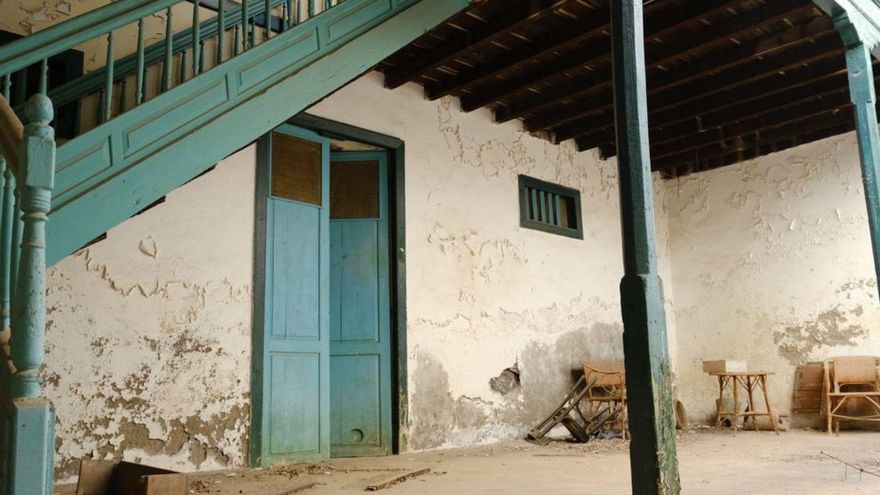
Bakery and pastry shop, leisure establishment, Civil Guard barracks, civil war office… At number 10 Calle Ayuntamiento there is a building from the second half of the 18th century that played a fundamental role in the history of the municipality Y in the configuration of the urban structure of the Guia de Isora Historical Site Asset of Cultural Interest. The Cabildo promotes its rehabilitation.
At number 10 Calle del Ayuntamiento, in the Guia de Isora town center, a building is built that the Isoranos know as Casa Lola –it was the name of the last owner who lived in it–, which they also refer to as Casa de la Cueva –before its construction, there was a cave in the place that was integrated in the basement of the building. The house was built in the second half of the 18th century, following the traditional style of the time. It is well preserved, but very deteriorated. The council has commissioned the drafting of the project and construction management to rehabilitate the construction to the company Proyectos de Arquitectura Álvarez Muñoz, for 119,256 euros and two and a half months to write the technical proposal.
The recovery of this building contemplates, specifically, fitting out the first floor as a multidisciplinary space, as diaphanous as possible, so that it can be used as a room for acoustic concerts, as a room for traveling exhibitions, to give talks and develop workshops. This same level will also serve as a space for events linked to historical and artistic heritage, with the possibility of organizing meetings on the roof due to its large size and because its location makes it a viewpoint towards the square and the tower of the church of Our Lady of the light.
The works are directed to the second floor being conditioned to be used as the venue for an exhibitionof a permanent nature, of the work of the Isorano painter Manuel Martín González (1905-1988), considered by experts to be one of the best Canarian landscape painters.
A bet of Josefa Mesa
This project was promoted from the Historical Heritage area of the Cabildo de Tenerife during the 2015-2019 mandate, a period in which the councilor of the area was Josefa Mesa Mora, today Mayor of Guia de Isora. “From the City Council we have been waiting for this project to be carried out for some time. We hope that this action will serve to continue with the rehabilitation and we will be closer to seeing Casa Lola converted into a space that acts as a dynamic element of the municipality. This must be a place of reference in which to carry out various cultural activities to make the Isorano town more attractive », she reflects in her capacity as councillor.
It was on the 11th when the Island Government Council awarded the drafting of the project and construction management, as a prelude to the tender for this “strategic” action for the area of Historical Heritage of the Cabildo, according to its current insular director of Patrimony, Emilio Fariña. The rehabilitation of Casa Lola or Casa de la Cueva is part of the interventions that are promoted “to rescue this legacy that is part of our traditions and identity.”
The property is located in the historic center, affected by the delimitation of the Well of Cultural Interest Historical Complex of Guía de Isora, declared as such by decree issued on March 10, 2009. It is a construction that is strategically located between Ayuntamiento and La Vera streets. It is a few meters from other historic buildings that house municipal facilities, such as the Town Hall, a construction dating from 1868; Social Services and the Local Development Agency, a building built in 1857 and known as Casa de los del Tagoro; as well as the House of Culture and Manuel Martín González Hall-Museum, a building from the 19th century, corresponding to the era of economic splendor of the Isorano municipality.
In this historic center dominates the flat roof civil and domestic architecture. It is made up of buildings that, “even with their original functions linked to the rural world, show a certain urban vocation, which is reflected both in the alignment of their openings and in some decorative details or the rationality and symmetry in the distribution of the openings of the facade, a characteristic that regulates urban facades since the second half of the 18th century”, according to the technical work that gave rise to this rehabilitation.
various uses
The relevance of Casa Lola in the Isorano context is reflected in its uses, even. This construction it was a bakery and candy store for a time, responding to the fame acquired by the Guia de Isora sweets. As a result of this activity, facilities such as the oven are still preserved in the house.
Added to this use is the one that it housed in its basement, where there was a popular entertainment establishment then known as La Cueva. In addition, it came to have institutional use. For years, Casa Lola was occupied as the headquarters of the Civil Guard and, during the development of the Spanish civil war, it was the place where “the war reports and the casualties recorded in the conflict were made public”.
Casa Lola or Casa de la Cueva is a building that has played a fundamental role in the history of the Isorano municipality and in shaping the urban structure of the historic center of Guía de Isora.
















